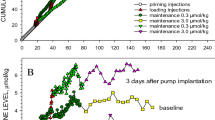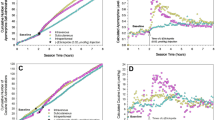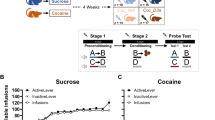Abstract
Systemic administration of caffeine reinstates extinguished cocaine self-administration behavior in rats, but the mechanism mediating this behavioral effect has not been established. The present study examined the role of adenosinergic A2 and dopaminergic mechanisms in caffeine-produced cocaine seeking. Following extinction of cocaine self-administration, experimenter-administered injections of caffeine (1.25–20 mg/kg) and theophylline (1–10 mg/kg) dose-dependently reinstated extinguished cocaine-seeking behavior. Administration of the adenosinergic A2 antagonist, 3,7-dimethyl-1-propargylxanthine (DMPX; 0.546–2.18 μg/kg), failed to produce cocaine seeking. Pretreatment with doses of the adenosine A1/A2 agonist 5′-N-ethylcarboxamidoadenosine (NECA; 0.003–0.03 mg/kg) that were below those that produced marked sedation failed to block reinstatement. These data suggest that methylxanthine-produced cocaine seeking is not due to adenosine A2 receptor antagonism. In contrast, pretreatment with the dopaminergic D1-like antagonist SCH 23390 (0.005–0.02 mg/kg) or the D2-like antagonist eticlopride (0.03–0.3 mg/kg) produced a dose-dependent attenuation of caffeine-produced reinstatement at doses that did not decrease cocaine self-administration. These findings suggest that dopaminergic mechanisms underlie the ability of caffeine to reinstate extinguished cocaine-taking behavior.
Similar content being viewed by others
Log in or create a free account to read this content
Gain free access to this article, as well as selected content from this journal and more on nature.com
or
References
Akimoto K, Mamamura T, Kazahaya Y, Akiyama K, Otsuki S . (1990): Enhanced extracellular dopamine level may be the fundamental neuropharmacological basis of cross-behavioral sensitization between methamphetamine and cocaine—an in vivo dialysis study in freely moving rats. Brain Res 507: 344–346
Baldo BA, Koob GF, Markou A . (1999): Role of adenosine A2 receptors in brain stimulation reward under baseline conditions and during cocaine withdrawal in rats. J Neurosci 19: 11017–11026
Caine SB, Koob GF . (1994): Effects of dopamine D-1 and D-2 antagonists on cocaine self-administration under different schedules of reinforcement in the rat. J Pharmacol Exp Ther 270: 209–218
Corrigall WA, Coen KM . (1991): Cocaine self-administration is increased by both D1 and D2 dopamine antagonists. Pharmacol Biochem Behav 39: 799–802
Daly JW . (1993): Mechanism of action of caffeine. In Garattini S (ed), Caffeine, Coffee, and Health. New York, Raven Press, Ltd., pp 97–149
Dasgupta S, Ferre S, Kull B, Hedlund PB, Finnman UB, Ahlberg S, Arenas E, Fredholm BB, Fuxe K . (1996): Adenosine A2A receptors modulate the binding characteristics of dopamine D2 receptors in stably cotransfected fibroblast cells. Eur J Pharmacol 316: 325–331
De Vries TJ, Schoffelmeer AN, Binnekade R, Vanderschuren LJ . (1999): Dopaminergic mechanisms mediating the incentive to seek cocaine and heroin following long-term withdrawal of IV drug self-administration. Psychopharmacology 143: 254–260
Elmer GI, Brockington A, Gorelick DA, Carrol FI, Rice KC, Matecka D, Goldberg SR, Rothman RB . (1996): Cocaine cross-sensitization to dopamine uptake inhibitors: unique effects of GBR12909. Pharmacol Biochem Bevav 53: 911–918
Fenu S, Morelli M . (1998): Motor stimulant effects of caffeine in 6-hydroxydopamine-lesioned rats are dependent on previous stimulation of dopamine receptors: a different role of D1 and D2 receptors. Eur J Neurosci 10: 1878–1884
Ferre S, Herrera-Marschitz M, Grabowska-Anden M, Casas M, Ungerstedt U, Anden NE . (1991): Postsynaptic dopamine/adenosine interaction: II. Postsynaptic dopamine agonism and adenosine antagonism of methylxanthines in short-term reserpinized mice. Eur J Pharmacol 192: 31–37
Ferre S, O'Connor WT, Fuxe K, Ungerstedt U . (1993): The striopallidal neuron: a main locus for adenosine-dopamine interactions in the brain. J Neurosci 13: 5402–5406
Fuxe K, Ferre S, Zoli M, Agnati LF . (1998): Integrated events in central dopamine transmission as analyzed at multiple levels. Evidence for intramembrane adenosine A2A/ dopamine D2 and Adenosine A1/dopamine D1 receptor interactions in the basal ganglia. Brain Res Rev 26: 258–273
Garrett BE, Holtzman SG . (1995): Does adenosine receptor blockade mediate caffeine-induced rotational behavior? J Pharmacol Exp Ther 274: 207–214
Holtzman SG . (1991): CGS 15943, a nonxanthine adenosine receptor antagonist: effects on locomotor activity of nontolerant and caffeine-tolerant rats. Life Sci 49: 1563–1570
Horger BA, Wellman PJ, Morien A, Davies BT, Schenk S . (1991): Caffeine exposure sensitizes rats to the reinforcing effects of cocaine. Neuroreport 2: 53–56
Jaffe JH, Cascella NG, Kumor KM, Sherer MA . (1989): Cocaine-induced cocaine craving. Psychopharmacology 97: 59–64
Katims JJ, Annau Z, Snyder SH . (1983): Interactions in the behavioral effects of methylxanthines and adenosine derivatives. J Pharmacol Exp Ther 227: 167–173
Khroyan TV, Barrett-Larimore RL, Rowlett JK, Spealman RD . (2000): Dopamine D1- and D2-like receptor mechanisms in relapse to cocaine-seeking behavior: effects of selective antagonists and agonists. J Pharmacol Exp Ther 294: 680–687
Kuzmin A, Johansson B, Zvartau EE, Fredholm BB . (1999): Caffeine, acting on adenosine A1 receptors, prevents the extinction of cocaine-seeking behavior in mice. J Pharmacol Exp Ther 290: 535–542
Markou A, Weiss F, Gold LH, Caine SB, Schulteis G, Koob GF . (1993): Animal models of drug craving. Psychopharmacology 112: 163–182
Mumford GK, Holtzman SG . (1990): Methylxanthines elevate reinforcement threshold for electrical brain stimulation: role of adenosine receptors and phosphodiesterase inhibition. Brain Res 528: 32–38
Mumford GK, Holtzman SG . (1991a): Do adenosinergic substrates mediate methylxanthine effects upon reinforcement thresholds for electrical brain stimulation in the rat? Brain Res 550: 172–178
Mumford GK, Holtzman SG . (1991b): Qualitative differences in the discriminative stimulus effects of low and high doses of caffeine in the rat. J Pharmacol Exp Ther 258: 857–865
Rush CR, Sullivan JT, Griffiths RR . (1995): Intravenous caffeine in stimulant drug abusers: subjective reports and physiological effects. J Pharmacol Exp Ther 273: 351–358
Schenk S, Valadez A, Horger BA . (1989): Caffeine preexposure sensitizes rats to the motor activating effects of cocaine. Behav Pharmacol 1: 447–451
Schenk S, Worley CM, McNamara C, Valadez A . (1996): Acute and repeated exposure to caffeine: effects on reinstatement of extinguished cocaine-taking behavior in rats. Psychopharmacology 126: 17–23
Schenk S, Partridge B . (1999): Cocaine-seeking produced by experimenter-administered drug injections: dose-effect relationships in rats. Psychopharmacology 147: 285–290
Schenk S, Partridge B, Shippenberg TS . (2000): Reinstatement of extinguished drug-taking behavior in rats: effect of the kappa-opioid receptor agonist U69593. Psychopharmacology 151: 85–90
Self DW, Barnhart WJ, Lehman DA, Nestler EJ . (1996): Opposite modulation of cocaine-seeking behavior by D1- and D2-like dopamine receptor agonists. Science 271: 1586–1589
Snyder SH, Katims JJ, Annau Z, Bruns RF, Daly JW . (1981): Adenosine receptors and behavioral actions of methylxanthines. Proc Natl Acad Sci 78: 3260–3264
Spencer DG Jr, Emmett-Oglesby MW . (1985): Parallel processing strategies in the application of microcomputers to the behavioral laboratory. Behav Res Methods Instrum 17: 294–300
Svenningsson P, Nomikos GG, Ongini E, Fredholm BB . (1997): Antagonism of adenosine A2A receptors underlies the behavioral activating effect of caffeine and is associated with reduced expression of messenger RNA for NGFI-A and NGFI-B in caudate-putamen and nucleus accumbens. Neuroscience 3: 753–764
Wise RA, Murray A, Bozarth MA . (1990): Bromocriptine self-administration and bromocriptine-reinstatement of cocaine-trained and heroin-trained lever pressing in rats. Psychopharmacology 100: 355–360
de Wit H, Stewart J . (1981): Reinstatement of cocaine-reinforced responding in the rat. Psychopharmacology 75: 134–143
Worley CM, Valadez A, Schenk S . (1994): Reinstatement of extinguished cocaine-taking behavior by cocaine and caffeine. Pharmacol Biochem Behav 48: 217–221
Acknowledgements
These studies were supported by DA 10084. The authors wish to acknowledge the technical assistance of C. McNamera, B. Partridge and C. Grahlman.
Author information
Authors and Affiliations
Corresponding author
Rights and permissions
About this article
Cite this article
Green, T., Schenk, S. Dopaminergic Mechanism for Caffeine-Produced Cocaine Seeking in Rats. Neuropsychopharmacol 26, 422–430 (2002). https://doi.org/10.1016/S0893-133X(01)00343-8
Received:
Revised:
Accepted:
Published:
Issue date:
DOI: https://doi.org/10.1016/S0893-133X(01)00343-8
Keywords
This article is cited by
-
Caffeine, a common active adulterant of cocaine, enhances the reinforcing effect of cocaine and its motivational value
Psychopharmacology (2016)
-
Adenosine A2A Receptors in the Nucleus Accumbens Bi-Directionally Alter Cocaine Seeking in Rats
Neuropsychopharmacology (2012)
-
Effects of caffeine on persistence and reinstatement of nicotine-seeking behavior in rats: interaction with nicotine-associated cues
Psychopharmacology (2012)
-
The α4β2 nicotinic acetylcholine-receptor partial agonist varenicline inhibits both nicotine self-administration following repeated dosing and reinstatement of nicotine seeking in rats
Psychopharmacology (2010)
-
The adenosine receptor antagonist CGS15943 reinstates cocaine-seeking behavior and maintains self-administration in baboons
Psychopharmacology (2003)



